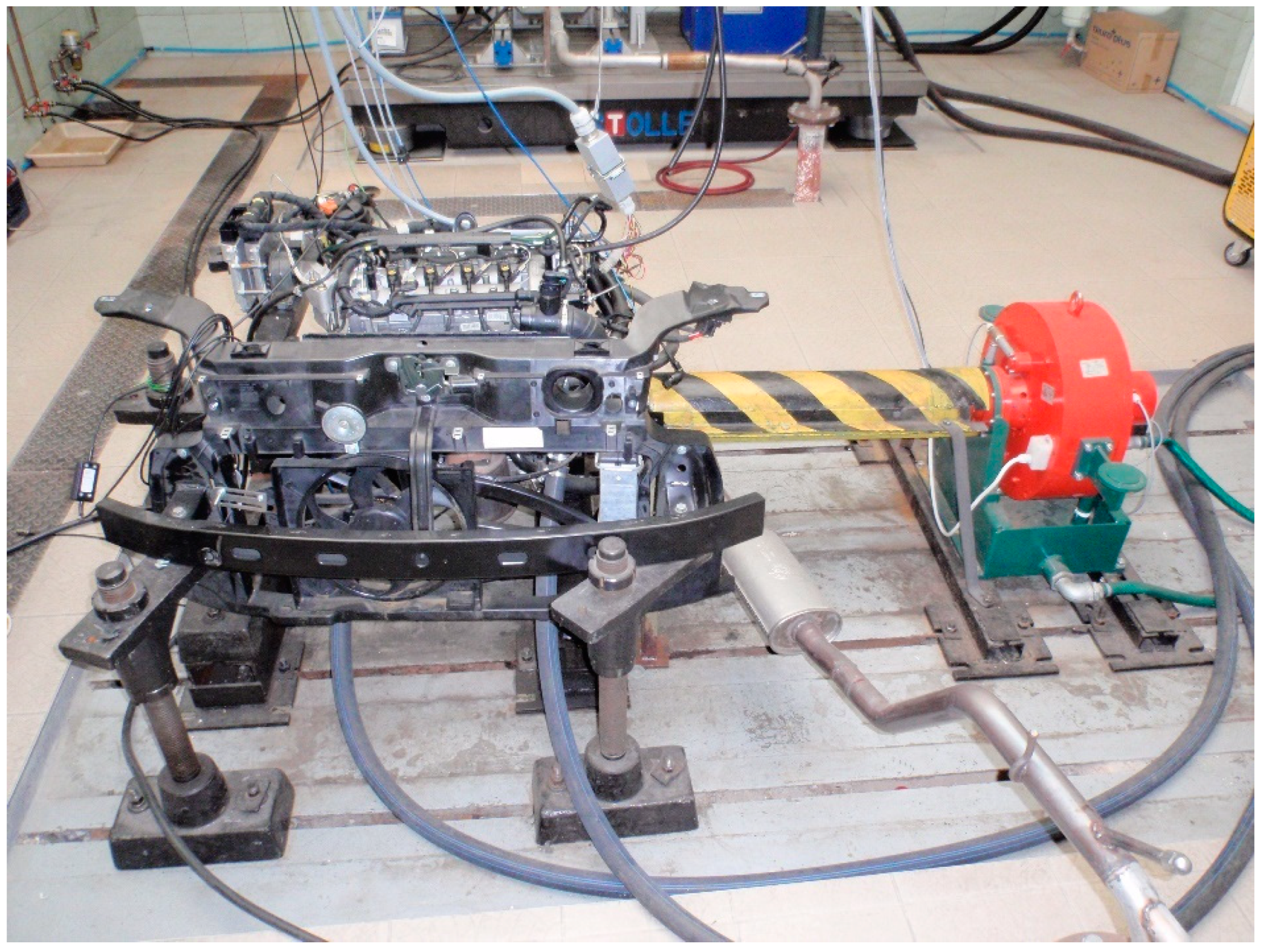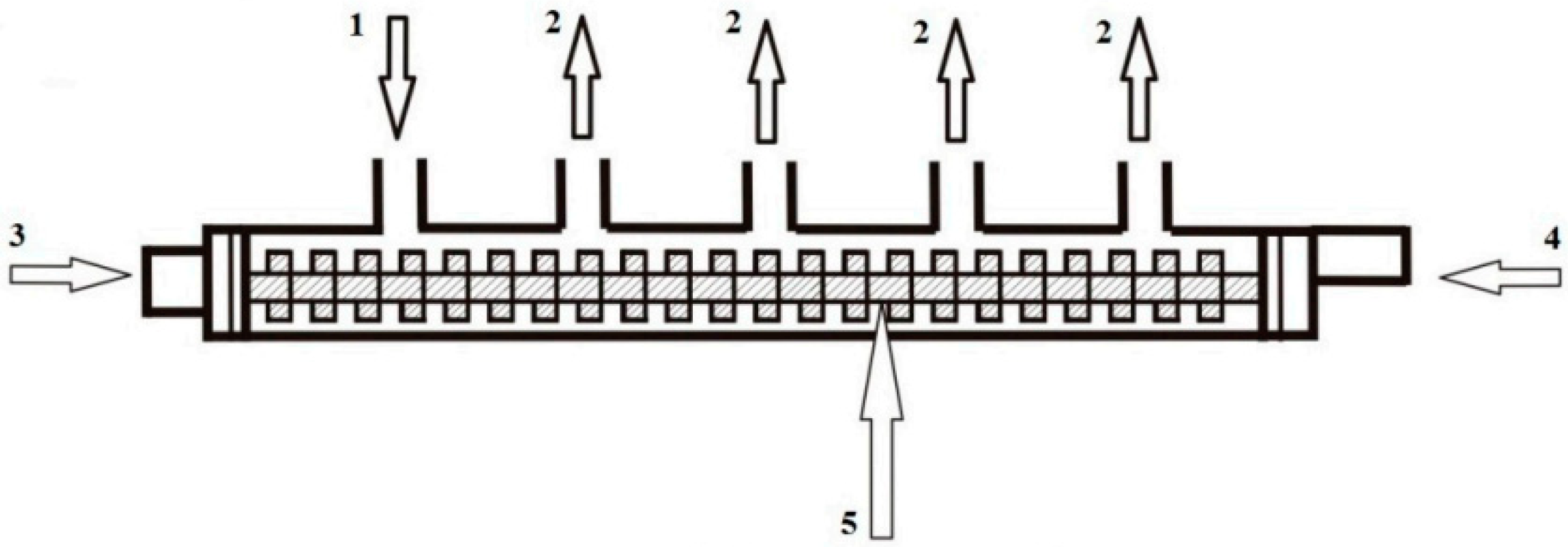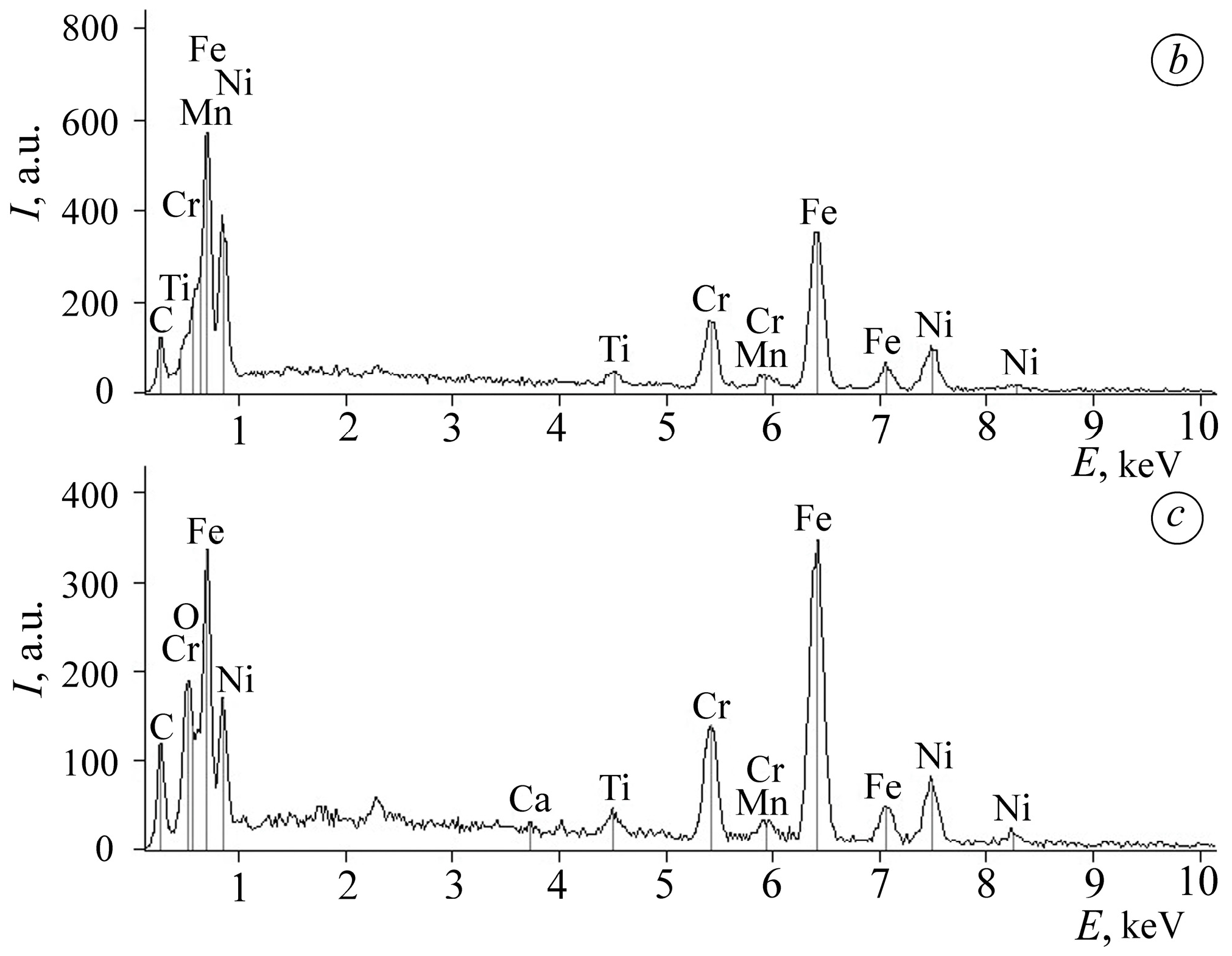Hydrogen-Containing Fuel Influence on Compression-Ignition Engine Part Wear and Emissions of Toxic Substances
Abstract
1. Introduction
2. Investigated Materials and Testing Methods
3. Results of Experiments and Discussion
4. Conclusions
- It was established that the environmental parameters of the engine are affected by the degree of wear and tear of the hot high-pressure tract.
- Fuel injector emissions increase under full load due to the wear of the precision valve and control piston pairs in a hydrogen-containing environment. As a result, the number of fuel injection doses increases and traces of cavitation damage were found on the surfaces of the valve seat.
- Hydrogen combustion optimization involves the maximum reduction of the content of toxic substances in exhaust gases. Accelerated wear of injection equipment elements depends on hydrogen-containing fuel, which also lubricates kinematic elements.
- If the socket is leaking, the fuel injector is constantly working and supplying fuel to the combustion chamber, especially at higher pressures and transient conditions. At the moment of increasing the load on the engine, the pressure and injection time of the fuel mixture increase, and therefore, its amount increases.
- An excess of fuel occurs in damaged injectors, which worsens combustion in the engine chamber due to incomplete oxidation of the combustible mixture and a decrease in flame temperature. Therefore, soot and carbon monoxide emissions increase.
Author Contributions
Funding
Data Availability Statement
Acknowledgments
Conflicts of Interest
References
- Jakliński, P.; Czarnigowski, J. An experimental investigation of the impact of added HHO gas on automotive emissions under idle conditions. Int. J. Hydrogen Energy 2020, 45, 13119–13128. [Google Scholar] [CrossRef]
- Jakliński, P. Studium Wpływu Dodatku Wodoru na Efektywność Pracy Tłokowego Silnika Spalinowego; Politechnika Lubelska: Lublin, Poland, 2017; 224 s; Available online: http://www.bc.pollub.pl/Content/13039/PDF/studium.pdf (accessed on 26 March 2025).
- Merkisz, J.; Izidor, M.; Bajerlem, M.; Daszkiewicz, P. The impact of hydrogen in diesel fuel on the parameters of engine performance. Mech. (Tech. Trans. Krakow Politech.) 2012, 109, 261–274. Available online: https://yadda.icm.edu.pl/baztech/search/page.action?qt=SEARCH&q=sc.general*c_0all_0eq.2_2%2509Jakli%25C5%2584ski%252C%2BP_2%2BStudium%2BWp%25C5%2582ywu%2BDodatku%2BWodoru%2Bna%2BEfektywno%25C5%259B%25C4%2587%2BPracy%2BT%25C5%2582okowego%2BSilnika%2BSpalinowego%253B%2BPolitechnika%2BLubelska%253A%2BLublin%252C%2BPoland%252C%2B2017%253B%2B224%2Bs_2%2B*l_0 (accessed on 26 March 2025).
- Ambrozik, A.; Ambrozik, T.; Łagowski, P. Fuel impact on emissions of harmful components of the exhaust gas from the CI engine during cold start up. Eksploat. i Niezawodn.–Maint. Reliab. 2015, 17, 95–99. Available online: https://yadda.icm.edu.pl/baztech/search/page.action?qt=SEARCH&q=sc.general*c_0all_0eq.Ambrozik%252C%2BA_2%253B%2BAmbrozik%252C%2BT_2%253B%2B%25C5%2581agowski%252C%2BP_2%2BFuel%2Bimpact%2Bon%2Bemissions%2Bof%2Bharmful%2Bcomponents%2Bof%2Bthe%2Bexhaust%2Bgas%2Bfrom%2Bthe%2BCI%2Bengine%2Bduring%2Bcold%2Bstart%2Bup_2%2BEksploat_2%2Bi%2BNiezawodn_2%25E2%2580%2593Maint_2%2BReliab_2%2B2015%252C%2B17%252C%2B95%25E2%2580%259399_2%2B*l_0 (accessed on 26 March 2025). [CrossRef]
- Gis, W.; Merkisz, J. The development status of electric (BEV) and hydrogen (FCEV) passenger cars park in the world and new research possibilities of these cars in real traffic conditions. Combust. Engines 2019, 178, 144–149. [Google Scholar] [CrossRef]
- Balyts’kyi, O.I.; Chmiel, J.; Krause, P.; Niekrasz, J.; Maciag, M. Role of hydrogen in the cavitation fracture of 45 steel in lubricating media. Mater. Sci. 2009, 45, 651–654. [Google Scholar] [CrossRef]
- Balyts’kyi, O.I.; Ivaskevich, L.M.; Mochylskii, V.M. Mechanical properties of martensitic steels in gaseous hydrogen. Strength Mater. 2012, 44, 64–73. [Google Scholar] [CrossRef]
- Balitska, V.; Shpotyuk, Y.; Filipecki, J.; Shpotyuk, O.; Iovu, M. Post-irradiation relaxation in vitreous arsenic/antimony trisulphides. J. Non-Cryst. Solids 2011, 357, 487–489. [Google Scholar] [CrossRef]
- Balitskii, A.; Kindrachuk, M.; Volchenko, D.; Abramek, K.F.; Balitskii, O.; Skrypnyk, V.; Zhuravlev, D.; Bekish, I.; Ostashuk, M.; Kolesnikov, V. Hydrogen containing nanofluids in the spark engine’s cylinder head cooling system. Energies 2022, 15, 59. [Google Scholar] [CrossRef]
- Karamangil, M.I.; Taflan, R.A. Experimental investigation of effect of corrosion on injected fuel quantity and spray geometry in the diesel injection nozzles. Fuel 2013, 112, 531–536. [Google Scholar] [CrossRef]
- Knefel, T. Ocena techniczna wtryskiwaczy Common Rail na podstawie doświadczalnych badań przelewów. Eksploat. Niezawodnosc.–Maint. Reliab. 2012, 14, 42–53. [Google Scholar]
- Wrobel, R.; Sierzputowski, G.; Sroka, Z.; Dimitrov, R. Comparison of diesel engine vibroacoustic properties powered by bio and standard fuel. Energies 2021, 14, 1478. [Google Scholar] [CrossRef]
- Rajput, R.K. A Textbook of Manufacturing Technology (Manufacturing Processes); Laxmi Publ.: New Delhi, India, 2007; 900p. [Google Scholar]
- Simon, L.; Moraes, C.A.M.; Modolo, R.C.E.; Vargas, M.; Calheiro, D.; Brehm, F.A. Recycling of contaminated metallic chip based on eco-efficiency and eco-effectiveness approaches. J. Clean. Prod. 2017, 153, 417–424. [Google Scholar] [CrossRef]
- Rovin, L.E.; Zayac, T.M.; Valickaya, O.M. Recycling of ferrous metal shavings. Cast. Metall. 2017, 89, 94–101. [Google Scholar] [CrossRef]
- Sommersel, O.K.; Vaagsaether, K.; Bjerketvedt, D. Hydrogen explosions in 20′ ISO container. Int. J. Hydrogen Energy 2017, 42, 7740–7748. [Google Scholar] [CrossRef]
- Gis, W.; Menes, E.; Waśkiewicz, J. Circumstances of the National Plan or Hydrogenization of Road Transport in Poland; Report Prepared as Part of the HIT-2-Corridors Project; ITS: Warsaw, Poland, 2015; 121p, Available online: https://www.teraz-srodowisko.pl/media/pdf/aktualnosci/4520-NIP-Poland.pdf (accessed on 26 March 2025).
- Merkisz, J.; Gis, M. The growth in the use of methane fuel for fuelling urban buses. In Proceedings of the 10th Conference on Interdisciplinary Problems in Environmental Protection and Engineering (EKO-DOK), Polanica-Zdrój, Poland, 16–18 April 2018; Available online: https://www.e3s-conferences.org/articles/e3sconf/pdf/2018/19/e3sconf_eko-dok2018_00109.pdf (accessed on 26 March 2025). [CrossRef]
- Gis, W.; Pielecha, J.; Waskiewicz, J. Use of certain alternative fuels in road transport in Poland. In IOP Conference Series: Materials Science and Engineering; IOP Publishing: Bristol, UK, 2016; Volume 148. [Google Scholar] [CrossRef]
- Gis, W. Electromobility and hydrogenization of the motor transport in Poland now and in the future. J. KONES Powertrain Transp. 2018, 25, 4. Available online: https://kones.eu/ep/2018/vol25/no4/95-102_J_O_KONES_2018_NO._4_VOL._25_ISSN_1231-4005_GIS.pdf (accessed on 26 March 2025).
- Balyts’kyi, O.I.; Kostyuk, I.F. Strength of welded joints of Cr-Mn steels with elevated content of nitrogen in hydrogen-containing media. Mater. Sci. 2009, 41, 97–107. [Google Scholar] [CrossRef]
- Balitskii, A.I.; Vytvytskyi, V.I.; Ivaskevich, L.M. The low-cycle fatigue of corrosion-resistant steels in high pressure hydrogen. Procedia Eng. 2010, 2, 367–2371. [Google Scholar] [CrossRef][Green Version]
- Pokhmurskii, V.I.; Vynar, V.A.; Vasyliv, C.B.; Ratska, N.B. Effects of hydrogen exposure on the mechanical and tribological properties of α-titanium surfaces. Wear 2013, 306, 47–50. [Google Scholar] [CrossRef]
- Khoma, M.S.; Ivashkiv, V.R.; Chuchman, M.R.; Vasyliv, C.B.; Ratska, N.B.; Datsko, B.M. Corrosion cracking of carbon steels of different structure in the hydrogen sulfide environment under static load. Proc. Struct. Integ. 2018, 13, 2184–2189. [Google Scholar] [CrossRef]
- Pokhmurskii, V.; Khoma, M.; Vynar, V.; Vasyliv, C.; Ratska, N.; Voronyak, T.; Stasyshyn, I. The influence of hydrogen desorption on micromechanical properties and tribological behavior of iron and carbon steels. Procedia Struct. Integ. 2018, 13, 2190–2195. [Google Scholar] [CrossRef]
- Shyrokov, V.; Maksymuk, A.; Vasyliv, C. Prediction of wear-resistant thin diffusive coatings. Tribol. Int. 2005, 38, 179–185. [Google Scholar] [CrossRef][Green Version]
- Balitska, V.; Filipecki, J.; Ingram, A.; Shpotyuk, O. Defect characterization methodology in sintered functional spinels with PALS technique. Phys. Status Solidi (C) Curr. Top. Solid State Phys. 2007, 4, 1317–1320. [Google Scholar] [CrossRef]
- Argawal, S.; Chhibber, V.K.; Bhatnagar, A.K. Tribological behavior of diesel fuels and the effect of anti—Wear additives. Fuel 2013, 106, 21–29. [Google Scholar]
- Brunhart, M.; Soteriou, C.; Daveau, C.; Gavaises, M. Cavitation erosion risk indicators for a thin gap within a diesel fuel pump. Wear 2020, 442, 203024. [Google Scholar]
- Chiavola, O.; Palmieri, F. Investigating the fuel type influence on Diesel CR pump performance. Energy Procedia 2018, 148, 908–915. [Google Scholar]
- Anis, S.; Budiandono, G.N. Investigation of the effects of preheating temperature of biodiesel—Diesel fuel blends on spray characteristics and injection pump performance. Renew. Energy 2019, 140, 274–280. [Google Scholar]
- Saltas, S.; Bouilly, J.; Geivanidis, S.; Samaras, Z.; Mohammadi, A.; Iida, Y. Investigation of the effects of biodiesel aging on the degradation of common rail fuel injection systems. Fuel 2017, 200, 357–370. [Google Scholar]
- Leicher, J.; Schaffert, J.; Cigarida, H.; Tali, E.; Burmeister, F.; Giese, A.; Albus, R.; Görner, K.; Carpentier, S.; Milin, P.; et al. The impact of hydrogen admixture into natural gas on residential and commercial gas appliances. Energies 2022, 15, 777. [Google Scholar] [CrossRef]
- Skalskyi, V.; Nazarchuk, Z.Z.; Stankevych, O.; Klym, B. Influence of occluded hydrogen on magnetoacoustic emission of low-carbon steels. Int. J. Hydrogen Energy 2023, 48, 6146–6156. [Google Scholar] [CrossRef]
- Baltacioglu, M.K.; Arat, H.T.; Özcanli, M.; Aydin, K. Experimental comparison of pure hydrogen and HHO (hydroxy) enriched biodiesel (B10) fuel in a commercial diesel engine. Int. J. Hydrogen Energy 2016, 41, 8347–8353. [Google Scholar] [CrossRef]
- Saravanan, N.; Nagarajan, G.; Dhanasekaran, C.; Kalaiselvan, K.M. Experimental investigation of hydrogen port fuel injection in DI diesel engine. Int. J. Hydrogen Energy 2007, 32, 4071–4080. [Google Scholar] [CrossRef]
- Sürer, M.G.; Arat, H.T. State of art of hydrogen usage as a fuel on aviation. Eur. Mech. Sci. 2018, 2, 20–30. [Google Scholar] [CrossRef]
- Balitskii, O.A.; Kolesnikov, V.O.; Balitskii, A.I.; Eliasz, J.J.; Havrylyuk, M.R. Hydrogen effect on the high-nickel surface steel properties during machining and wear with lubricants. Arch. Mater. Sci. Eng. 2020, 104, 49–57. [Google Scholar] [CrossRef]
- Sa’ed, A.; Musmar, A.; Al-Rousan, A. Effect of HHO gas on combustion emissions in gasoline engines. Fuel 2011, 90, 3066–3070. [Google Scholar] [CrossRef]
- PN-EN ISO 8178-1; Silniki Spalinowe Tłokowe. Pomiar Emisji Spalin. Pomiar Emisji Składników Gazowych i Cząstek Stałych na Stanowisku Badawczym. Wyd. Styczeń: Warszawa, Poland, 1999.
- Milojević, S.; Sawic, S.; Marić, D.; Stopka, O.; Krstić, B.; Stojanović, B. Correlation between Emission and Combustion Characteristics with the Compression Ratio and Fuel Injection Timing in Tribologically Optimized Diesel Engine. Teh. Vjesn. 2022, 29, 1210–1219. [Google Scholar] [CrossRef]
- Milojević, S.; Glišović, J.; Savić, S.; Bošković, G.; Bukvić, M.; Stojanović, B. Particulate matter emission and air pollution reduction by applying variable systems in tribologically optimized diesel engines for vehicles in road traffic. Atmosphere 2024, 15, 184. [Google Scholar] [CrossRef]
- Wang, L.; Lowrie, J.; Ngaile, G.; Fang, T. High injection pressure diesel sprays from a piezoelectric fuel injector. Appl. Therm. Eng. 2019, 152, 807–824. [Google Scholar] [CrossRef]








| Area | C [%] | O [%] | Na [%] | Si [%] | Cl [%] | Cr [%] | Fe [%] | Ni [%] | Mo [%] |
|---|---|---|---|---|---|---|---|---|---|
| 1 | 2.3 | 0.7 | 50.1 | 46.9 | |||||
| 2 | 2.4 | 3.3 | 0.8 | 37.3 | 56.1 | ||||
| 3 | 4.2 | 95.8 | |||||||
| 4 | 1.8 | 1.7 | 0.3 | 96.2 | |||||
| 5 | 2.4 | 0.5 | 1.9 | 96.0 | |||||
| 6 | 2.0 | 1.1 | 1.0 | 94.7 | |||||
| 7 | 43.5 | 49.8 | 1.2 | 0.6 | 1.9 | 2.9 | |||
| 8 | 40.2 | 51.7 | 1.8 | 1.3 | 1.0 | 1.3 | |||
| 9 | 6.1 | 4.2 | 0.7 | 89.1 | 1.7 | ||||
| 10 | 8.9 | 24.5 | 5.7 | 58.5 | 1.8 |
| Area | C [%] | O [%] | Mg [%] | Al [%] | Si [%] | K [%] | Ca [%] | Ti [%] | Cr [%] | Mn [%] | Fe [%] | Ni [%] |
|---|---|---|---|---|---|---|---|---|---|---|---|---|
| 1 | 11.8 | 6.0 | 1.6 | 80.5 | ||||||||
| 2 | 4.9 | 1.8 | 13.7 | 1.0 | 54.3 | 24.3 | ||||||
| 3 | 6.0 | 4.3 | 0.3 | 1.6 | 12.2 | 0.9 | 55.6 | 11.9 | ||||
| 4 | 12.5 | 82.8 | ||||||||||
| 5 | 3.5 | 29.2 | 65.8 | |||||||||
| 6 | 3.7 | 26.5 | 1.2 | 68.7 | ||||||||
| 7 | 2.9 | 31.1 | 1.4 | 64.7 | ||||||||
| 8 | 13.0 | 46.3 | 8.0 | 8.7 | 11.1 | 1.1 | 11.8 | |||||
| 9 | 52.5 | 1.6 | ||||||||||
| 10 | 12.0 | 44.1 | 9.1 | 7.7 | 13.2 | 1.0 |
Disclaimer/Publisher’s Note: The statements, opinions and data contained in all publications are solely those of the individual author(s) and contributor(s) and not of MDPI and/or the editor(s). MDPI and/or the editor(s) disclaim responsibility for any injury to people or property resulting from any ideas, methods, instructions or products referred to in the content. |
© 2025 by the authors. Licensee MDPI, Basel, Switzerland. This article is an open access article distributed under the terms and conditions of the Creative Commons Attribution (CC BY) license (https://creativecommons.org/licenses/by/4.0/).
Share and Cite
Balitskii, A.I.; Osipowicz, T.K.; Abramek, K.F.; Balitska, V.O.; Kochmański, P.; Królikowski, M.A. Hydrogen-Containing Fuel Influence on Compression-Ignition Engine Part Wear and Emissions of Toxic Substances. Energies 2025, 18, 1722. https://doi.org/10.3390/en18071722
Balitskii AI, Osipowicz TK, Abramek KF, Balitska VO, Kochmański P, Królikowski MA. Hydrogen-Containing Fuel Influence on Compression-Ignition Engine Part Wear and Emissions of Toxic Substances. Energies. 2025; 18(7):1722. https://doi.org/10.3390/en18071722
Chicago/Turabian StyleBalitskii, Alexander I., Tomasz K. Osipowicz, Karol F. Abramek, Valentina O. Balitska, Paweł Kochmański, and Marcin A. Królikowski. 2025. "Hydrogen-Containing Fuel Influence on Compression-Ignition Engine Part Wear and Emissions of Toxic Substances" Energies 18, no. 7: 1722. https://doi.org/10.3390/en18071722
APA StyleBalitskii, A. I., Osipowicz, T. K., Abramek, K. F., Balitska, V. O., Kochmański, P., & Królikowski, M. A. (2025). Hydrogen-Containing Fuel Influence on Compression-Ignition Engine Part Wear and Emissions of Toxic Substances. Energies, 18(7), 1722. https://doi.org/10.3390/en18071722








